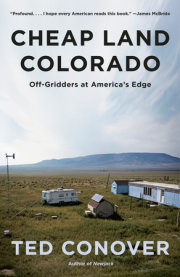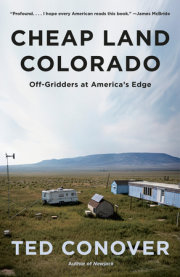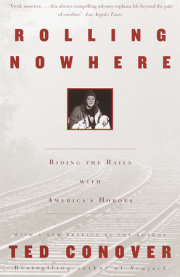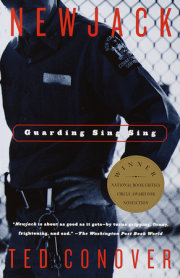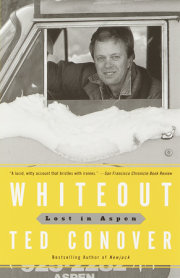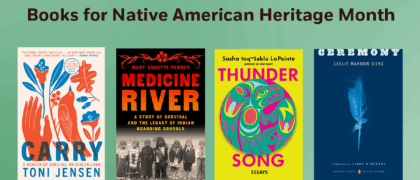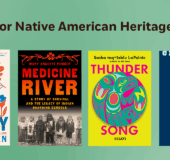1
Cheap Land Colorado
We come for the scale of it.
—Linda Gregerson, “Sleeping Bear”
These times are too progressive. Everything has changed too fast. Railroads and telegraph and kerosene and coal stoves—they’re good to have but the trouble is, folks get to depend on ’em.
—Laura Ingalls Wilder, The Long Winterb
My first experience of the San Luis Valley came on a family car trip when I was eleven. We stayed on the paved roads, but even that was impressive. The Great Sand Dunes National Monument, now Great Sand Dunes National Park and Preserve, looked like fake scenery from a movie until we were in it. I was amazed by its origin story: grains of sand blown from one side of this huge expanse, about the size of New Jersey, had formed gigantic dunes on the other. The San Juan mountains to the west hold the remains of an enormous ancient supervolcano whose eruption was possibly the largest explosion in the earth’s geologic history.
When you grow up in a beautiful place that seems to lose some beauty to settlement (i.e., development) every year, you treasure the unchanged. The San Luis Valley still looks much as it did one hundred, or even two hundred, years ago. Blanca Peak, at 14,345 feet the fourth highest summit in the Rockies, overlooks a vast openness. Blanca, named for the snow that covers its summit most of the year, is visible from almost everywhere in the valley and is considered sacred by the Navajo. The range Blanca presides over, the Sangre de Cristos, forms the valley’s eastern side. Nestled up against the range just north of Blanca are the amazing sand dunes. The valley tapers to a close down in New Mexico, a little north of Taos. It is not hard to picture the Indigenous people who carved images into rocks near the rivers, or the Hispanic people who established Colorado’s oldest town, San Luis, and a still working system of communal irrigation in the southeastern corner, or a pioneer wagon train. Pronghorn antelope still roam, as do feral horses and the occasional mountain lion.
It’s also not hard to see a through line between the homesteaders of the nineteenth century and the people who move out there today. The land is no longer free, but it is some of the cheapest in the United States. In many respects, a person could live in this vast, empty space like the pioneers did on the Great Plains, except you’d have a truck instead of a wagon and mule, and some solar panels, possibly even a weak cellphone signal. And legal weed. By selling or bartering weed and picking up seasonal labor, you might even get by without having a job, though if you have no income, things can get tricky, especially when winter comes around. It would be extremely difficult to live completely off the land, especially out on the open prairie.
I left Colorado for college, and again for grad school, and finally for New York and my city-loving wife. But on my office wall hangs my last Colorado license plate, from 1990. Family kept me coming back on visits, and often I would meet up with old friends. One of these was Jay, whose family had a cozy A-frame cabin in Fairplay, Colorado, about an hour and a half from Denver in another high basin, this one called South Park. Mocked as a backwater by the animated TV series, South Park is a great foil to the busy, popular Interstate 70 corridor that leads to ski areas like Copper Mountain and Vail. It is windy, mostly treeless, and sparsely populated. Jay’s family A-frame was in trees at the valley’s edge, but it got famously cold there in the winter (and often even in the summer). We did a lot of cross-country skiing in the backcountry and joined up with friends for parties there, starting in high school and continuing for many New Year’s Eves after.
In 2016 a Denver magazine called 5280 asked me to write about South Park. Jay and I reconvened there for a few days. The “park” is very wide, and we wanted to visit areas we’d never seen before. A local offered directions to one particularly remote area, musing that “once you’re on 53, you will swear you’ll never find your way back.” We headed there the next afternoon and found a place nearly devoid of people that was overlaid with dirt roads from a moribund 1970s subdivision that had never taken off, just as in the San Luis Valley. This area, a few months before, had made the news as the home of a disturbed man named Robert Dear who had attacked a Planned Parenthood clinic in Colorado Springs, killing three people and injuring eight. The New York Times ran a photo of the little trailer he lived in on five acres. The trailer was surrounded by snow and miles of empty space, the very picture of isolation and desolation. I thought, What would it be like to live out there? What would drive you to it? Who would you get to know? How would you manage?
We saw some isolated trailers and shacks and assumed a handful of people were living off-grid. We heard from a teacher in Fairplay that some of the kids from that area had parents with pretty extreme religious views, which had created friction with the school district. We knew that the local sheriff’s department had recently had shoot-ups with white supremacists in remote parts of South Park. We had to pause, as we drove around, to wait for a herd of bison to finish crossing the dirt road we were on, leap over a fallen gate on the far side, and move into an empty field. We kept looking for a cowboy who might have sent them on their way, but they seemed to be on their own.
Denver and New York are complex urban areas. Out here, by contrast, it seemed that life must be simple, but how could I really know? That feeling of ignorance grew stronger a month later, in November, when Donald Trump was elected president of the United States. The day before, in New York, I had told a French radio station that Trump could never win the election. (Of course, I had plenty of company in this delusion.) The American firmament was shifting in ways I needed to understand, and these empty, forgotten places seemed an important part of that.
I told my sister about the place. In her work for a Denver-based foundation, she said, she had recently visited Alamosa, the San Luis Valley’s biggest town, and heard about off-grid settlement on a much larger scale. Staffers from a social service group called La Puente had shown her slides of how people were living out on “the flats” and told her about their Rural Outreach initiative; later she sent me some photos in a pdf file. I got in touch with La Puente, which had begun as a homeless shelter—one of the first rural homeless shelters in the country—founded by a nun. And then I visited.
Lance Cheslock, the executive director, showed me around, starting with lunch at the shelter. It’s a big old house on the humbler side of Alamosa, converted to allow for separate facilities for men, women (who get buzzed into their part of the upstairs), and families, for whom there are separate bedrooms. There are forty-five beds in all, but on this day in June, only twenty-six guests were registered. Most of the downstairs is a dining room and kitchen. The shelter was serving three meals a day, with lunch and dinner open to walk-ins from the community—but only after enough diners had signed up to clean the kitchen afterward. The AmeriCorps volunteer assigned to this task wasn’t having luck. Lance, a good persuader, took the clipboard from her and began walking down the queue, making it clear that nobody would be served until people were in place to clean up. Soon he had his volunteers, and not long after we sat down at a table for six, along with shelter clients and a staff person, the shelter’s director, Teotenantzin Ruybal.
Tona, as she was known, had grown up in the valley and had run the shelter for more than nine years. She was from one of the extended families that have been in the area for generations and identify as Hispanic. (The terms “Latino” and “Latinx” are less often used in the valley.) Her demeanor was on the gruff side—you can’t run a shelter if you’re a pushover—but it was clear from our conversation that she had a big heart and was deeply committed to helping the poor.
She explained the direct link between the shelter and the off-gridders I was interested in: “You’re living in a slum, and you see an ad about owning five acres for five thousand dollars, and you have a view of Blanca Peak—to them it’s an opportunity, it’s the savage wild, their piece of the rock.” People would come to the valley just to own their own place, free from landlords and utility bills. And free also from being judged: “Sometimes the attitude is, I’d rather live a rough life out there than live in town and be looked down on,” Tona explained.
“Regardless of if it’s a stupid choice, it’s their choice,” she continued. But it wasn’t always sustainable, because though they might be living on their own land they still were poor, with slender margins for surviving if things went wrong. Often, said Tona, they turned up at the shelter once it got cold and they saw how unforgiving the winter could be. The most durable off-gridders often had a fixed income of some sort—veterans’ benefits, for example, or Social Security disability payments—because otherwise it was hard to make a living. The flats were far from jobs, and getting to jobs required reliable transportation, which many lacked.
Tona’s partner, Robert, was a former corrections officer and sheriff’s deputy who had spent a year and a half as La Puente’s first Rural Outreach worker. That weekend Tona and Robert drove me out to the flats for a tour. We met in the little town of Antonito—the last town before the New Mexico border—on a day that was unusual because it was overcast. Tona and Robert lived outside town, in the countryside but not off-grid, with three Chihuahuas; one of them, Diego, came along for the ride. We rendezvoused at the Family Dollar store, where I parked my truck and transferred into their SUV.
Antonito was once a center for sheepherding and the wool trade and a stop on the Denver & Rio Grande Western railroad. It still had a bronze statue of Don Celedonio Mondragón, a labor organizer, next door to the empty onetime lodge of the Sociedad Protección Mutua de Trabajadores Unidos (SPMDTU), the union he founded for shepherds and farmworkers circa 1900. Amid some empty storefronts, Antonito had two marijuana stores, two liquor stores, a grocery store, and two good Mexican restaurants. It had the seasonal Cumbres & Toltec narrow-gauge railroad, a tourist draw, as well as a baroque outsider art structure known as Cano’s Castle. It had a small hotel with a tame pig that lived outside and wore a purple collar. But to me, the coolest thing about Antonito was what Tona and Robert were about to show me: its unsung status as a gateway to the flats.
From the Family Dollar, we crossed the tracks and headed east. Town quickly yielded to irrigated farmland. A huge center-pivot sprinkler shot water onto the road, forcing Tona to turn on the windshield wipers. Interspersed among humble houses were some very old mobile homes and, even older, some decaying one- and two-room adobe houses, their mud bricks slowly eroding away. The pavement ended at a small church, the Sagrada Familia Mission, past which a small bridge lifted the dirt road over an irrigation ditch, and then in a mile or two the irrigation ditch ran out, too: no more trees, no more agriculture, and not many fences. We entered a large tract administered by the Bureau of Land Management, and the horizon dropped lower and lower. Tona’s SUV shot over one cattle guard, then another, and another, now in a terrain of low sagebrush and chico bushes, a cloud of dust shooting up behind us. We were in a very pretty, gentle saddle between two sets of rounded hills, and the view kept getting wider and longer.
Finally, as we topped a rise, the whole of the giant San Luis Valley seemed to spread out in front of us. On the far eastern side were the still-snowcapped Sangre de Cristo Mountains, many of them higher than thirteen or fourteen thousand feet. The most prominent was Blanca Peak. Way to the south was rounded Ute Mountain, in New Mexico, which the valley extended into. Between them they cradled a huge volume of space that rested on a vast tawny plain that Tona and Robert called “the flats” and most locals, as I would learn, called “the prairie.”
The road ahead of us continued gently downhill toward a dark, narrow notch in the landscape that was the Rio Grande River. As we got closer, a pattern became visible on the flats—the same sort of giant grid I had seen in South Park. These roads had been cut across the land as part of a real estate scheme in the 1970s. Closer yet and a few dwellings and former dwellings came into view, most of them trailers, some of them trailers augmented with small additions. Tona braked as the road narrowed to a one-lane iron bridge, the Lobatos Bridge, built in 1892. Its deck was two long courses of thick wooden planks that thumped and creaked as we drove slowly over them, with the Rio Grande River below, mostly shallow, its canyon not deep.
The area had been Robert’s Rural Outreach beat for over a year, until January 2017, when he hurt himself on the job lifting heavy boxes of food. (Matt Little was just getting started at this point.) Robert hadn’t been back in five months, and as we drove up from the river and onto a road he used to visit, he marveled at the several dwellings that had appeared since the winter, and at what had been abandoned. Several times he referred to what I heard as “groves” behind wooden fences or in temporary greenhouses; I pictured fruit trees. But when I asked for more details, Robert explained that he was referring to people’s “grows”—shorthand for marijuana gardens. The option of being able to grow marijuana legally had attracted many residents to the area, he explained. Those with medical marijuana permits could grow up to ninety-nine plants. The limit for others was six, which was often exceeded without legal consequence.
Copyright © 2022 by Ted Conover. All rights reserved. No part of this excerpt may be reproduced or reprinted without permission in writing from the publisher.



